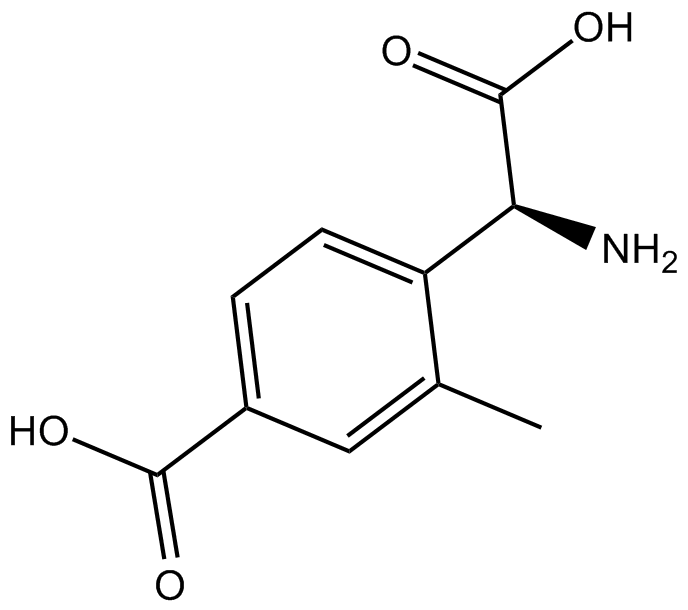LY 367385 |
| Catalog No.GC12831 |
mGlu1a receptor antagonist
Products are for research use only. Not for human use. We do not sell to patients.

Cas No.: 198419-91-9
Sample solution is provided at 25 µL, 10mM.
IC50: 8.8 μM
LY 367385 is a selective mGlu1a receptor antagonist for blockade of quisqualate-induced phosphoinositide hydrolysis.
The mGlu family of G-protein-linked glutamate receptors currently comprises eight members by 3,5-dihydroxyphenylglycine can activate specifically Group I mGlu receptors, which have been found to regulate multiple effects in the vertebrate brain.
In vitro: Compared with the activity of LY367385, the novel compound LY367366 antagonizes both mGlu1a and -5 receptors at low micromolar concentrations, but also recruits other subtypes at higher concentrations. LY367366 possessing neuroprotective ability was in general less efficacious than LY357385. This fact suggested that inhibitors of mGlu1 receptors is a potential agent to confer significant neuroprotection [1].
In vivo: LY 367385 and AIDA have been administered intracerebroventricularly (i.c.v.) to lethargic mice and DBAr2 mice, and focally into the inferior colliculus of GEPR. In lethargic mice both compounds significantly decrease the incidence of spontaneous spike and wave discharges on the electroencephalogram, after the administration of LY 367385, 250 nmol, i.c.v. LY 367385, 50 nmol, inhibites spontaneous spike and wave discharges from 30 to 60 min. In DBAr2 mice both compounds produce a rapid, transient suppression of sound-induced clonic seizures. In genetically epilepsy prone rats, both compounds decreases sound-induced clonic seizures. The results suggestes that antagonists of mGlu1 receptors are potential anticonvulsant tools and that activation of mGlu1 receptors likely contributes to a variety of epilepticsyndromes [2].
Clinical trial: So far, no clinical study has been conducted.
References:
[1]. Bruno V, Battaglia G, Kingston A, O'Neill MJ, Catania MV, Di Grezia R, Nicoletti F. Neuroprotective activity of the potent and selective mGlu1a metabotropic glutamate receptor antagonist, (+)-2-methyl-4 carboxyphenylglycine (LY367385): comparison with LY357366, a broader spectrum antagonist with equal affinity for mGlu1a and mGlu5 receptors. Neuropharmacology. 1999 Feb;38(2):199-207.
[2]. Chapman AG, Yip PK, Yap JS, Quinn LP, Tang E, Harris JR, Meldrum BS. Anticonvulsant actions of LY 367385 ((+)-2-methyl-4-carboxyphenylglycine) and AIDA ((RS)-1-aminoindan-1,5-dicarboxylic acid). Eur J Pharmacol. 1999 Feb 26;368(1):17-24.
Average Rating: 5 (Based on Reviews and 6 reference(s) in Google Scholar.)
GLPBIO products are for RESEARCH USE ONLY. Please make sure your review or question is research based.
Required fields are marked with *




















